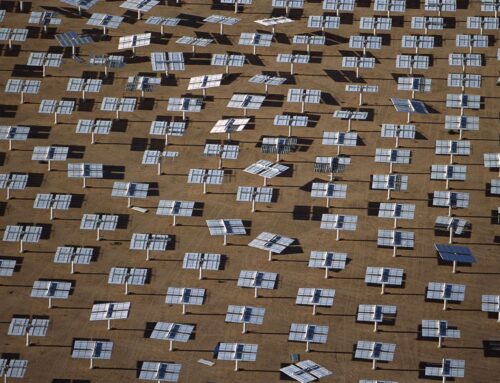Will Tariffs on Solar Cell Imports Invigorate the U.S. Manufacturing Market?
May 1, 2025
The U.S. Department of Commerce determined last week solar cell imports from four Southeast Asian countries should see tariffs of up to 3,521 percent.
It’s a move that broadens the trade dispute between the U.S. and China, as mainland manufacturers have set up factories in Cambodia, Thailand, Vietnam and Malaysia in recent years.
The rate determinations come after a yearlong investigation by the Commerce Department. The agency looked into claims by American producers that Chinese companies with operations in the four Southeast Asian countries were selling solar cells and panels in the U.S. at artificially low prices.
This practice is known as dumping. It’s when a product is sold in an importing country (in this case, the U.S.) for less than the price of that product in the exporting country’s market.
The coalition of American solar manufacturers who raised the claim also alleged that China is subsidizing these countries’ solar cell production and should face countervailing duties. Before American manufacturers brought their case forward, the Commerce Department found in 2023 that certain Chinese producers shipped their solar products through Cambodia, Malaysia, Thailand and Vietnam for minor processing in an attempt to avoid paying existing antidumping and countervailing duties.
Now, the north of 3,500 percent figure is not the rate most of these companies would be facing if these tariffs take effect. That is, unless you are one of the solar equipment exporters in Cambodia. They are set to face the highest duties because of what was seen as a lack of cooperation with the Commerce Department’s investigation. (The Commerce Department maintains more than 700 antidumping and countervailing duty orders, according to the agency.)
Representatives for the Commerce Department did not immediately respond to a request for comment on the solar tariffs.
But products made in Malaysia by Chinese manufacturer Jinko Solar, for example, face some of the lowest duties of just over 41 percent. Another China-based firm, Trina Solar, would see tariffs of 375 percent for the products it makes in Thailand.
Whether or not these rates see the light of day depends on a separate agency, the International Trade Commission (ITC), to make its final injury determination. The ITC has until June 2 to decide if each country caused material injury or not. If a negative determination is made, no order would be issued. If the ITC finds an affirmative determination, the rate orders would be issued on June 9.
Before we keep going, I should introduce myself. I’m Arcelia Martin, Inside Climate News’s Texas-based renewable energy reporter. I’m stepping in this week for Inside Clean Energy’s usual author, Dan Gearino. OK, back to solar.
While nothing is set in stone yet, these tariffs could change the pace of the U.S. solar industry and the country’s expansion of clean energy sources. In 2024, more than 80 percent of the nation’s solar panels were imported from Cambodia, Malaysia, Thailand and Vietnam. And in 2023, the U.S. imported almost $12 billion in solar equipment from the four countries, according to figures from the U.S. Census Bureau.
The American Alliance for Solar Manufacturing Trade Committee, made up of leading U.S. solar manufacturers from across the country including Convalt Energy, First Solar, Meyer Burger, Mission Solar, Qcells, REC Silicon and Swift Solar, alleged that the dumping and subsidization of products made in Southeast Asia to avoid trade rules led to a glut of solar panels being sold below the cost of production.
The trade group argues that American solar manufacturing is on the cusp of growth, ready to introduce new U.S. jobs and propel the country’s clean energy transition.
But that momentum is being thwarted by China’s industrial policy and how it injures domestic producers, said Tim Brightbill, lead counsel to the American Alliance for Solar Manufacturing Trade Committee.
They’re thrilled about the final rate determination last week.
“This is a decisive victory for American manufacturing and confirms what we’ve long known: that Chinese-headquartered solar companies have been cheating the system, undercutting U.S. companies, and costing American workers their livelihoods,” Brightbill said.
For the coalition, the goal of these tariffs is to level the playing field so U.S. solar manufacturers can actually compete.
But Abigail Ross Hopper, the president and CEO of the Solar Energy Industries Association (SEIA), one of the largest solar and storage trade groups in the U.S., with more than 1,200 members, testified that the investigation and its subsequent tariffs are counterproductive both for the future of solar manufacturing and solar deployment in the United States.
She pointed out that while there’s 52 gigawatts of module production capacity in the U.S. and another 47 gigawatts either announced or under construction, cell capacity is lagging well behind, with only 2 gigawatts of operational cell production capacity.
Cell plants take much longer to build out than module plants because they require more electrical power than modular manufacturing. It’s also trickier to secure utility connections, Hopper said, and the environmental details of cell plants are more complex to iron out when it comes to siting, zoning and permitting.
“U.S. module producers are now competitive with imports, but only if they have access to cells, which today means imported cells,” Hopper said. “Imposition of duties on cells makes no sense when there is negligible cell production in the United States.”
This story is funded by readers like you.
Our nonprofit newsroom provides award-winning climate coverage free of charge and advertising. We rely on donations from readers like you to keep going. Please donate now to support our work.
The U.S. solar energy industry installed almost 50 GW of capacity in 2024, a 21 percent increase from 2023. SEIA, in partnership with Wood Mackenzie, an energy analytics firm, projects that installations in 2025 and 2026 will again be near 50 GW per year, more than twice the 23 GW installed in 2022.
“The outlook remains bright for the entire U.S. supply chain, including domestic manufacturers – as long as this case doesn’t undermine that projected growth,” Hopper wrote in testimony supporting a negative determination from the ITC.
In November, the Commerce Department set preliminary duties on crystalline solar cell imports from the four Southeast Asian countries, with tariffs ranging from 21 percent to as high as 271 percent, depending on the country and manufacturing company.
In anticipation of further tariffs after the preliminary duties were announced in 2024, some manufacturers already shifted their supply chains and used solar cells produced outside of Malaysia, Vietnam, Cambodia and Thailand, according to a 2025 Sustainable Energy Report published by BloombergNEF and the Business Council for Sustainable Energy.
Modules from Laos were imported into the U.S. market on a large scale for the first time in July 2024, the study reported. In October, modules from Laos and Indonesia reached 0.27 GW and 0.26 GW, respectively, making them the fifth- and sixth-largest countries of origin for solar modules.
First Solar, a member of the American Alliance for Solar Manufacturing Trade Committee, lowered its annual sales and profit forecast on Tuesday due to tariff-related challenges thanks to the ongoing U.S.-China trade war and a cooling residential demand in the U.S., it reported. The company expects current-year net sales to be between $4.5 billion and $5.5 billion, compared to its previous projection of $5.3 billion to $5.8 billion.
Regardless of challenges from the new tariffs, First Solar is bullish on its ability to serve U.S. solar demand, said Mark Widmar, the company’s CEO. It’s a belief based on First Solar’s profile as the largest and most established module manufacturer and its network of domestic supply chain vendors, Widmar said.
Other stories about the energy transition to take note of this week:
Tariffs are Dominating Clean Energy Earnings Calls: For four big renewable companies that have reported results so far—Enphase, GE Vernova, Tesla and NextEra—tariffs were prominently mentioned in either their earnings reports or their analyst calls, reports Heatmap News’ Matthew Zeitlin. GE Vernova said that tariffs would result in $300 million to $400 million of additional costs.
Wyoming Is Moving Fast Toward New Nuclear Technologies: The state is eyeing advanced nuclear plants to put electricity on the grid and power energy-intensive industries like mining. Some business leaders dream of a Wyoming supply chain for atomic energy, Najifa Farhat reports for Inside Climate News.
Good Luck Getting a Gas Turbine: The Texas Energy Fund made low-interest, state-backed loans eligible to 17 energy developers for gas plants across the state.The goal was to get more gas quickly connected to the state grid. But developers are dropping out of the Texas Energy Fund as they await gas turbines and are faced with market restraints, Jason Plautz at E&E News reports.
Inside Clean Energy is ICN’s weekly bulletin of news and analysis about the energy transition. Send news tips and questions to [email protected].
About This Story
Perhaps you noticed: This story, like all the news we publish, is free to read. That’s because Inside Climate News is a 501c3 nonprofit organization. We do not charge a subscription fee, lock our news behind a paywall, or clutter our website with ads. We make our news on climate and the environment freely available to you and anyone who wants it.
That’s not all. We also share our news for free with scores of other media organizations around the country. Many of them can’t afford to do environmental journalism of their own. We’ve built bureaus from coast to coast to report local stories, collaborate with local newsrooms and co-publish articles so that this vital work is shared as widely as possible.
Two of us launched ICN in 2007. Six years later we earned a Pulitzer Prize for National Reporting, and now we run the oldest and largest dedicated climate newsroom in the nation. We tell the story in all its complexity. We hold polluters accountable. We expose environmental injustice. We debunk misinformation. We scrutinize solutions and inspire action.
Donations from readers like you fund every aspect of what we do. If you don’t already, will you support our ongoing work, our reporting on the biggest crisis facing our planet, and help us reach even more readers in more places?
Please take a moment to make a tax-deductible donation. Every one of them makes a difference.
Thank you,
Search
RECENT PRESS RELEASES
Related Post




